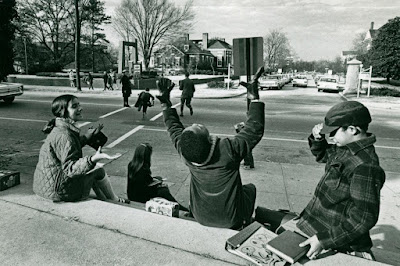On February 18, 1891, the North Carolina Legislature passed “An Act to Establish and Normal and Industrial School,” officially chartering the institution that would become UNC Greensboro. As the State Normal and Industrial School, the institution focused heavily on training women to become teachers in North Carolina’s public schools. As part of this training, the institution established a practice school so that students could gain practical classroom experience as part of their education.
State Normal opened its practice and observation school in 1893 under the direction of Philander P. Claxton. Initially, the school had ten pupils, with ages ranging from five to eight. Two of these pupils were the children of State Normal president Charles Duncan McIver. Classes were held in rooms within the Wooden Dormitory, one of two student residence halls on the State Normal campus.
By 1898, the practice school student body had grown to nearly 200 pupils, and the school was officially incorporated into the Greensboro public school system. The Wooden Dormitory building also grew to accommodate the expanding student population. Meanwhile, McIver and others at State Normal advocated for funding to build a separate building on campus to hold the practice school.
In 1902, that goal was finally achieved and the new practice school building opened. Named after Jabez Lamar Monroe Curry, who helped advocate for the founding of the State Normal, the practice school building was located on College Avenue. With the new building came even more growth in the practice school student body. Beginning in 1913, the Curry School added each year a new grade from eighth to eleventh (which was at the time the state’s standard senior year). It produced its first high school graduating class in 1917. Due to interruptions from World War I, however, Curry School would not graduate another class until 1927.
In the mid-1920s, construction on a new and more modernized Curry School Building on Spring Garden Street began. As the new building was nearing completion in 1926, the original Curry building on College Avenue burned to the ground. Faulty electric wiring and poor original construction were to blame for the fire. The portico framing the front entrance to the building was the only part of the structure to survive. It remained in place for over a decade, with students referring to it as “the ruins.”
By this point, well over a third of the juniors and seniors at the college (known in 1926 as the North Carolina College for Women) were education majors. Many others majored in a specific subject area but planned to teach high school after graduation. The Curry School population also grew, with an enrollment of 402 students in December 1928. A kindergarten was added in 1935 and the twelfth grade of high school in 1946. Total enrollment at the Curry School, however, remained steady, due primarily to the size of its building. In 1944, the school reportedly had a lengthy waiting list and rejected numerous applicants.
By the 1950s, the number of students at Woman’s College who needed practice teaching experience greatly outpaced the ability of the Curry School to offer them on-campus opportunities. More and more students found these experiences in other local public schools. Additionally, the facilities at the Curry School had deteriorated to the point that a candidate for the school’s deanship in 1958 proclaimed it the worst he had ever seen.
A state bond referendum in 1959 helped improve the physical plant. The repairs and additions included the construction in 1961 of Park Gymnasium next door to the Curry School Building. But by this time, the small student body and the limitations in offerings for high school students (both varieties of classes and extracurricular activities) started to impact the school. Additionally, Curry’s operating costs per pupil were almost double that of the other nearby public schools.
Outside consultants and an education faculty study in 1966 all recommended closure of at least the high school at Curry. Robert O’Kane, dean of the School of Education, agreed and the high school officially closed in 1969. The elementary grades (kindergarten through sixth grade) followed in 1970. Today, the Curry School building remains on Spring Garden (although the Park Gymnasium was razed in 2004 to make way for the Moore Humanities and Research Administration Building).
By Erin Lawrimore


